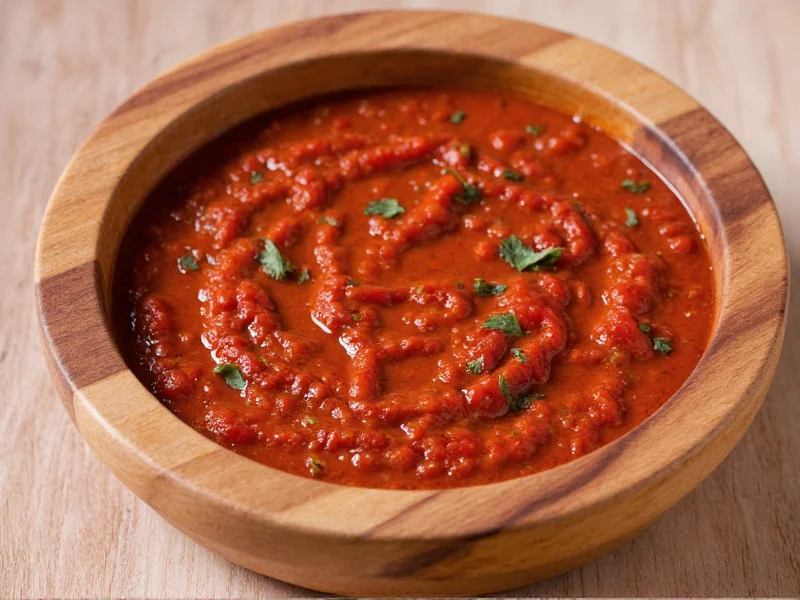Understanding harissa's distinctive taste is essential for both novice cooks and experienced chefs looking to elevate their dishes with this North African staple. This vibrant chili paste has gained global popularity not just for its heat, but for the remarkable depth it adds to recipes. Unlike many hot sauces that focus solely on spiciness, authentic harissa provides a sophisticated flavor journey that enhances rather than overwhelms.
Breaking Down Harissa's Flavor Components
When describing what does harissa taste like, it's helpful to examine its primary flavor dimensions. The magic happens through the careful balance of several elements that work in harmony:
| Flavor Component | Primary Contributors | Intensity Level | How It Manifests |
|---|---|---|---|
| Heat | Baklouti peppers, serranos, or bird's eye chilies | Moderate to Very Hot | Builds gradually rather than immediate burn |
| Smokiness | Roasted red peppers, sometimes smoked paprika | Moderate to Strong | Earthy depth from charring process |
| Tanginess | Vinegar, lemon juice, or preserved lemon | Mild to Moderate | Cleanses palate, balances heat |
| Earthy Notes | Garlic, cumin, coriander | Moderate | Provides foundation for other flavors |
| Oiliness | Olive oil base | Moderate | Carries flavors, creates smooth texture |
Key Ingredients That Define Authentic Harissa Flavor
The distinctive harissa flavor profile stems from specific ingredients traditionally used in Tunisian preparation. Unlike commercial versions that might cut corners, authentic harissa relies on:
- Roasted red peppers - Typically Baklouti peppers in Tunisia, though other regional varieties use serrano or bird's eye chilies. The roasting process develops complex sugars that create that signature smoky-sweet foundation.
- Garlic - Fresh garlic provides pungent undertones that mellow when cooked, adding depth without overwhelming.
- Spice blend - Coriander and caraway seeds are toasted and ground, contributing warm, citrusy notes that distinguish harissa from other hot sauces.
- Acid component - Vinegar or lemon juice balances the heat and preserves the paste, adding brightness to the overall profile.
- Olive oil - High-quality olive oil serves as both preservative and flavor carrier, creating the characteristic smooth texture.
Regional Variations in Harissa Taste
While Tunisian harissa represents the original formulation, neighboring countries have developed their own interpretations that affect the harissa taste profile:
- Tunisian harissa - Considered the gold standard, featuring a balanced heat with prominent smokiness and garlic notes. Traditional versions use Baklouti peppers which provide moderate heat with complex flavor.
- Algerian harissa - Often includes tomatoes, creating a slightly sweeter, less intense heat profile with more pronounced acidity.
- Moroccan harissa - Typically incorporates additional spices like saffron or rose petals in some regional variations, resulting in a more floral, aromatic profile.
- Libyan harissa - Known for being exceptionally hot, often using spicier pepper varieties with less emphasis on the balancing spices.
Understanding these regional differences helps explain why some harissa products taste significantly different from others, addressing common confusion about what gives harissa its distinctive flavor.
How Harissa Heat Compares to Other Popular Hot Sauces
Many people wonder how harissa heat level compares to familiar hot sauces. Unlike sriracha which delivers immediate, sharp heat primarily from red jalapeños, harissa's heat builds gradually thanks to the roasted pepper base. The Scoville rating for traditional harissa ranges from 3,000-10,000 units, placing it between jalapeño peppers (2,500-8,000) and cayenne peppers (30,000-50,000).
Compared to gochujang, harissa offers a brighter, more acidic profile with less sweetness. While both are fermented chili pastes, gochujang's fermented soybean base creates an earthier, umami-rich flavor, whereas harissa's olive oil base yields a cleaner heat that works well across Mediterranean and Middle Eastern cuisines.
Practical Applications: Using Harissa Based on Its Flavor Profile
Knowing harissa flavor profile characteristics helps determine optimal usage in cooking. The paste's balanced heat and complexity make it versatile beyond just adding spice:
- Marinades - The acidity helps tenderize proteins while the oil carries flavors deep into meat or vegetables
- Sauces and dressings - A teaspoon transforms mayonnaise, yogurt, or vinaigrettes with complex heat
- Stews and braises - Adds depth to tomato-based sauces and bean dishes without overwhelming other ingredients
- Roasted vegetables - Toss root vegetables with harissa before roasting for caramelized, spicy-sweet results
- Breakfast applications - Swirled into scrambled eggs or mixed with avocado for toast
When incorporating harissa into recipes, remember that its flavor develops and mellow slightly when cooked. For raw applications like dressings, start with smaller amounts and adjust to taste, as the heat feels more intense when uncooked.
Maintaining Harissa's Flavor Integrity
Proper storage significantly impacts how harissa taste evolves over time. Authentic harissa should be stored in an airtight container with a thin layer of olive oil on top to prevent oxidation. Refrigerated, it maintains optimal flavor for 3-4 weeks, though commercially preserved versions may last longer.
Noticeable flavor degradation occurs when harissa develops off-notes or the oil separates significantly. High-quality harissa should never taste rancid or lose its vibrant red color. When comparing harissa taste to description on packaging, trust your senses—authentic harissa should smell pleasantly spicy and earthy, not musty or stale.
Common Misconceptions About Harissa Flavor
Several myths persist about harissa's taste profile that deserve clarification:
- "All harissa is extremely hot" - While some varieties pack serious heat, traditional Tunisian harissa focuses on flavor balance. Many commercial versions exaggerate the heat for Western palates.
- "Harissa tastes like other hot sauces" - Unlike vinegar-forward Tabasco or sweet Sriracha, harissa's olive oil base and roasted pepper foundation create a distinctly different flavor experience.
- "Harissa is just spicy paste" - Quality harissa offers nuanced flavor beyond heat, with layers of smokiness, garlic, and warm spices that enhance rather than dominate dishes.
Understanding these distinctions helps explain why harissa has become a chef's secret weapon for adding complex flavor rather than just heat to dishes.











 浙公网安备
33010002000092号
浙公网安备
33010002000092号 浙B2-20120091-4
浙B2-20120091-4